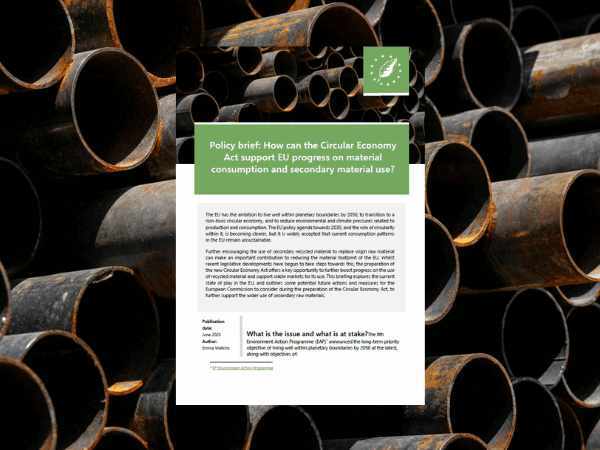AUTHOR: Emma Watkins
The EU aims to live within planetary boundaries, transition to a circular economy, and reduce environmental and climate pressures from production and consumption. However, current consumption patterns are unsustainable. The use of secondary recycled material can reduce the EU’s material footprint, and the new Circular Economy Act offers a key opportunity for further action.
The EU has the ambition to live well within planetary boundaries by 2050, to transition to a non-toxic circular economy, and to reduce environmental and climate pressures related to production and consumption. The EU policy agenda towards 2030, and the role of circularity within it, is becoming clearer, but it is widely accepted that current consumption patterns in the EU remain unsustainable.
Further encouraging the use of secondary recycled material to replace virgin raw material can make an important contribution to reducing the material footprint of the EU. Recent legislative developments have begun to take steps towards this, including the Critical Raw Materials Act, the Ecodesign for Sustainable Products Regulation and various new and amended waste and product legislation.
Looking ahead, the preparation of the new Circular Economy Act offers a key opportunity to further boost progress on the use of recycled material and support viable markets for its use. This briefing explores the current state of play in the EU, and outlines some potential future actions and measures for consideration during the preparation of the Circular Economy Act.
To ensure that the Circular Economy Act will contribute to supporting the wider use of secondary raw materials in the EU, the briefing suggests that the European Commission should consider the following aspects during preparation of the Act:
- Setting a target or targets to reduce the EU’s material footprint
- Setting targets for secondary material use (in addition to those in existing legislation)
- Outlining the EU funds available to support the development of infra-structure and markets for secondary raw materials
- Exploring actions related to material exports, for example export fees, re-strictions or third country partnerships
- Actively promoting cooperation between key actors, including through the proposed Trans-Regional Circularity Hubs, demand aggregation platform, SRM matchmaking mechanism and Critical Raw Material Centre
- Introducing extended producer responsibility measures to maximise the collection and revalorisation of valuable materials (including critical raw materials), including through fee differentiation or modulation
- Setting well-targeted and actionable green public procurement rules to boost demand and encourage markets for secondary raw materials
- Exploring taxation options such as lowering tax on second-hand products, secondary raw materials and circular purchasing
- Clarifying and simplifying waste definitions and end-of-waste criteria
- Clarifying the link between the Circular Economy Act and the implementation of the Ecodesign for Sustainable Products Regulation.
Cover photo by Engin Akyurt on Unsplash

